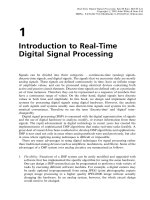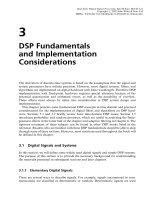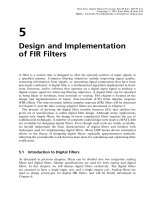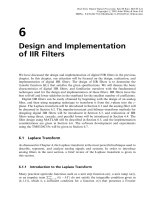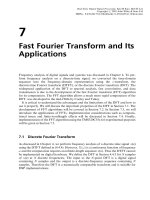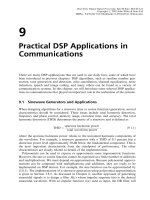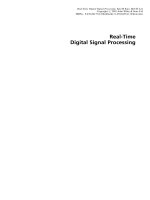Tài liệu Real time digital signal processing P1 pptx
Bạn đang xem bản rút gọn của tài liệu. Xem và tải ngay bản đầy đủ của tài liệu tại đây (438.21 KB, 34 trang )
1
Introduction to Real-Time
Digital Signal Processing
Signals can be divided into three categories ± continuous-time (analog) signals,
discrete-time signals, and digital signals. The signals that we encounter daily are mostly
analog signals. These signals are defined continuously in time, have an infinite range
of amplitude values, and can be processed using electrical devices containing both
active and passive circuit elements. Discrete-time signals are defined only at a particular
set of time instances. Therefore they can be represented as a sequence of numbers that
have a continuous range of values. On the other hand, digital signals have discrete
values in both time and amplitude. In this book, we design and implement digital
systems for processing digital signals using digital hardware. However, the analysis
of such signals and systems usually uses discrete-time signals and systems for math-
ematical convenience. Therefore we use the term `discrete-time' and `digital' inter-
changeably.
Digital signal processing (DSP) is concerned with the digital representation of signals
and the use of digital hardware to analyze, modify, or extract information from these
signals. The rapid advancement in digital technology in recent years has created the
implementation of sophisticated DSP algorithms that make real-time tasks feasible. A
great deal of research has been conducted to develop DSP algorithms and applications.
DSP is now used not only in areas where analog methods were used previously, but also
in areas where applying analog techniques is difficult or impossible.
There are many advantages in using digital techniques for signal processing rather
than traditional analog devices (such as amplifiers, modulators, and filters). Some of the
advantages of a DSP system over analog circuitry are summarized as follows:
1. Flexibility. Functions of a DSP system can be easily modified and upgraded with
software that has implemented the specific algorithm for using the same hardware.
One can design a DSP system that can be programmed to perform a wide variety of
tasks by executing different software modules. For example, a digital camera may
be easily updated (reprogrammed) from using JPEG ( joint photographic experts
group) image processing to a higher quality JPEG2000 image without actually
changing the hardware. In an analog system, however, the whole circuit design
would need to be changed.
Real-Time Digital Signal Processing. Sen M Kuo, Bob H Lee
Copyright # 2001 John Wiley & Sons Ltd
ISBNs: 0-470-84137-0 (Hardback); 0-470-84534-1 (Electronic)
2. Reproducibility. The performance of a DSP system can be repeated precisely from
one unit to another. This is because the signal processing of DSP systems work
directly with binary sequences. Analog circuits will not perform as well from each
circuit, even if they are built following identical specifications, due to component
tolerances in analog components. In addition, by using DSP techniques, a digital
signal can be transferred or reproduced many times without degrading its signal
quality.
3. Reliability. The memory and logic of DSP hardware does not deteriorate with
age. Therefore the field performance of DSP systems will not drift with changing
environmental conditions or aged electronic components as their analog counter-
parts do. However, the data size (wordlength) determines the accuracy of a DSP
system. Thus the system performance might be different from the theoretical expect-
ation.
4. Complexity. Using DSP allows sophisticated applications such as speech or image
recognition to be implemented for lightweight and low power portable devices. This
is impractical using traditional analog techniques. Furthermore, there are some
important signal processing algorithms that rely on DSP, such as error correcting
codes, data transmission and storage, data compression, perfect linear phase filters,
etc., which can barely be performed by analog systems.
With the rapid evolution in semiconductor technology in the past several years, DSP
systems have a lower overall cost compared to analog systems. DSP algorithms can be
developed, analyzed, and simulated using high-level language and software tools such as
C=C and MATLAB (matrix laboratory). The performance of the algorithms can be
verified using a low-cost general-purpose computer such as a personal computer (PC).
Therefore a DSP system is relatively easy to develop, analyze, simulate, and test.
There are limitations, however. For example, the bandwidth of a DSP system is
limited by the sampling rate and hardware peripherals. The initial design cost of a
DSP system may be expensive, especially when large bandwidth signals are involved.
For real-time applications, DSP algorithms are implemented using a fixed number of
bits, which results in a limited dynamic range and produces quantization and arithmetic
errors.
1.1 Basic Elements of Real-Time DSP Systems
There are two types of DSP applications ± non-real-time and real time. Non-real-time
signal processing involves manipulating signals that have already been collected and
digitized. This may or may not represent a current action and the need for the result
is not a function of real time. Real-time signal processing places stringent demands
on DSP hardware and software design to complete predefined tasks within a certain
time frame. This chapter reviews the fundamental functional blocks of real-time DSP
systems.
The basic functional blocks of DSP systems are illustrated in Figure 1.1, where a real-
world analog signal is converted to a digital signal, processed by DSP hardware in
2
INTRODUCTION TO REAL-TIME DIGITAL SIGNAL PROCESSING
Other digital
systems
Anti-aliasing
filter
ADC
x(n)
DSP
hardware
Other digital
systems
DAC
Reconstruction
filter
y(n)
x(t)
xЈ(t)
Amplifier
Amplifier
y(t)
yЈ(t)
Input channels
Output channels
Figure 1.1 Basic functional blocks of real-time DSP system
digital form, and converted back into an analog signal. Each of the functional blocks in
Figure 1.1 will be introduced in the subsequent sections. For some real-time applica-
tions, the input data may already be in digital form and/or the output data may not need
to be converted to an analog signal. For example, the processed digital information may
be stored in computer memory for later use, or it may be displayed graphically. In other
applications, the DSP system may be required to generate signals digitally, such as
speech synthesis used for cellular phones or pseudo-random number generators for
CDMA (code division multiple access) systems.
1.2 Input and Output Channels
In this book, a time-domain signal is denoted with a lowercase letter. For example, xt
in Figure 1.1 is used to name an analog signal of x with a relationship to time t. The time
variable t takes on a continuum of values between ÀI and I. For this reason we say
xt is a continuous-time signal. In this section, we first discuss how to convert analog
signals into digital signals so that they can be processed using DSP hardware. The
process of changing an analog signal to a xdigital signal is called analog-to-digital (A/D)
conversion. An A/D converter (ADC) is usually used to perform the signal conversion.
Once the input digital signal has been processed by the DSP device, the result, yn,is
still in digital form, as shown in Figure 1.1. In many DSP applications, we need to
reconstruct the analog signal after the digital processing stage. In other words, we must
convert the digital signal yn back to the analog signal yt before it is passed to an
appropriate device. This process is called the digital-to-analog (D/A) conversion, typi-
cally performed by a D/A converter (DAC). One example would be CD (compact disk)
players, for which the music is in a digital form. The CD players reconstruct the analog
waveform that we listen to. Because of the complexity of sampling and synchronization
processes, the cost of an ADC is usually considerably higher than that of a DAC.
1.2.1 Input Signal Conditioning
As shown in Figure 1.1, the analog signal, x
H
t, is picked up by an appropriate
electronic sensor that converts pressure, temperature, or sound into electrical signals.
INPUT AND OUTPUT CHANNELS
3
For example, a microphone can be used to pick up sound signals. The sensor output,
x
H
t, is amplified by an amplifier with gain value g. The amplified signal is
xtgx
H
t: 1:2:1
The gain value g is determined such that xt has a dynamic range that matches the
ADC. For example, if the peak-to-peak range of the ADC is Æ5 volts (V), then g may be
set so that the amplitude of signal xt to the ADC is scaled between Æ 5V. In practice, it
is very difficult to set an appropriate fixed gain because the level of x
H
t may be
unknown and changing with time, especially for signals with a larger dynamic range
such as speech. Therefore an automatic gain controller (AGC) with time-varying gain
determined by DSP hardware can be used to effectively solve this problem.
1.2.2 A/D Conversion
As shown in Figure 1.1, the ADC converts the analog signal xt into the digital signal
sequence xn. Analog-to-digital conversion, commonly referred as digitization, consists
of the sampling and quantization processes as illustrated in Figure 1.2. The sampling
process depicts a continuously varying analog signal as a sequence of values. The basic
sampling function can be done with a `sample and hold' circuit, which maintains the
sampled level until the next sample is taken. Quantization process approximates a
waveform by assigning an actual number for each sample. Therefore an ADC consists
of two functional blocks ± an ideal sampler (sample and hold) and a quantizer (includ-
ing an encoder). Analog-to-digital conversion carries out the following steps:
1. The bandlimited signal xt is sampled at uniformly spaced instants of time, nT,
where n is a positive integer, and T is the sampling period in seconds. This sampling
process converts an analog signal into a discrete-time signal, xnT, with continuous
amplitude value.
2. The amplitude of each discrete-time sample is quantized into one of the 2
B
levels,
where B is the number of bits the ADC has to represent for each sample. The
discrete amplitude levels are represented (or encoded) into distinct binary words
xn with a fixed wordlength B. This binary sequence, xn, is the digital signal for
DSP hardware.
x(t)
Ideal sampler
x(nT)
Quantizer
x(n)
A/D converter
Figure 1.2 Block diagram of A/D converter
4
INTRODUCTION TO REAL-TIME DIGITAL SIGNAL PROCESSING
The reason for making this distinction is that each process introduces different distor-
tions. The sampling process brings in aliasing or folding distortions, while the encoding
process results in quantization noise.
1.2.3 Sampling
An ideal sampler can be considered as a switch that is periodically open and closed every
T seconds and
T
1
f
s
, 1:2:2
where f
s
is the sampling frequency (or sampling rate) in hertz (Hz, or cycles per
second). The intermediate signal, xnT, is a discrete-time signal with a continuous-
value (a number has infinite precision) at discrete time nT, n 0, 1, ..., I as illustrated
in Figure 1.3. The signal xnT is an impulse train with values equal to the amplitude
of xt at time nT. The analog input signal xt is continuous in both time and
amplitude. The sampled signal xnT is continuous in amplitude, but it is defined
only at discrete points in time. Thus the signal is zero except at the sampling instants
t nT.
In order to represent an analog signal xt by a discrete-time signal xnT accurately,
two conditions must be met:
1. The analog signal, xt, must be bandlimited by the bandwidth of the signal f
M
.
2. The sampling frequency, f
s
, must be at least twice the maximum frequency com-
ponent f
M
in the analog signal xt. That is,
f
s
! 2 f
M
: 1:2:3
This is Shannon's sampling theorem. It states that when the sampling frequency is
greater than twice the highest frequency component contained in the analog signal, the
original signal xt can be perfectly reconstructed from the discrete-time sample xnT.
The sampling theorem provides a basis for relating a continuous-time signal xt with
Time, t
x(nT)
0 T 2T 3T 4T
x(t)
Figure 1.3 Example of analog signal xt and discrete-time signal xnT
INPUT AND OUTPUT CHANNELS
5
the discrete-time signal xnT obtained from the values of xt taken T seconds apart. It
also provides the underlying theory for relating operations performed on the sequence
to equivalent operations on the signal xt directly.
The minimum sampling frequency f
s
2f
M
is the Nyquist rate, while f
N
f
s
=2is
the Nyquist frequency (or folding frequency). The frequency interval Àf
s
=2, f
s
=2
is called the Nyquist interval. When an analog signal is sampled at sampling frequency,
f
s
, frequency components higher than f
s
=2 fold back into the frequency range 0, f
s
=2.
This undesired effect is known as aliasing. That is, when a signal is sampled
perversely to the sampling theorem, image frequencies are folded back into the desired
frequency band. Therefore the original analog signal cannot be recovered from the
sampled data. This undesired distortion could be clearly explained in the frequency
domain, which will be discussed in Chapter 4. Another potential degradation is due to
timing jitters on the sampling pulses for the ADC. This can be negligible if a higher
precision clock is used.
For most practical applications, the incoming analog signal xt may not be band-
limited. Thus the signal has significant energies outside the highest frequency of
interest, and may contain noise with a wide bandwidth. In other cases, the sampling
rate may be pre-determined for a given application. For example, most voice commu-
nication systems use an 8 kHz (kilohertz) sampling rate. Unfortunately, the maximum
frequency component in a speech signal is much higher than 4 kHz. Out-of-band signal
components at the input of an ADC can become in-band signals after conversion
because of the folding over of the spectrum of signals and distortions in the discrete
domain. To guarantee that the sampling theorem defined in Equation (1.2.3) can be
fulfilled, an anti-aliasing filter is used to band-limit the input signal. The anti-aliasing
filter is an analog lowpass filter with the cut-off frequency of
f
c
f
s
2
: 1:2:4
Ideally, an anti-aliasing filter should remove all frequency components above the
Nyquist frequency. In many practical systems, a bandpass filter is preferred in order
to prevent undesired DC offset, 60 Hz hum, or other low frequency noises. For example,
a bandpass filter with passband from 300 Hz to 3200 Hz is used in most telecommunica-
tion systems.
Since anti-aliasing filters used in real applications are not ideal filters, they cannot
completely remove all frequency components outside the Nyquist interval. Any fre-
quency components and noises beyond half of the sampling rate will alias into the
desired band. In addition, since the phase response of the filter may not be linear, the
components of the desired signal will be shifted in phase by amounts not proportional to
their frequencies. In general, the steeper the roll-off, the worse the phase distortion
introduced by a filter. To accommodate practical specifications for anti-aliasing filters,
the sampling rate must be higher than the minimum Nyquist rate. This technique is
known as oversampling. When a higher sampling rate is used, a simple low-cost anti-
aliasing filter with minimum phase distortion can be used.
Example 1.1: Given a sampling rate for a specific application, the sampling period
can be determined by (1.2.2).
6
INTRODUCTION TO REAL-TIME DIGITAL SIGNAL PROCESSING
(a) In narrowband telecommunication systems, the sampling rate f
s
8 kHz,
thus the sampling period T 1=8 000 seconds 125 ms (microseconds).
Note that 1 ms 10
À6
seconds.
(b) In wideband telecommunication systems, the sampling is given as
f
s
16 kHz, thus T 1=16 000 seconds 62:5 ms.
(c) In audio CDs, the sampling rate is f
s
44:1 kHz, thus T 1=44 100 seconds
22:676 ms.
(d) In professional audio systems, the sampling rate f
s
48 kHz, thus
T 1=48 000 seconds 20:833 ms.
1.2.4 Quantizing and Encoding
In the previous sections, we assumed that the sample values xnT are represented
exactly with infinite precision. An obvious constraint of physically realizable digital
systems is that sample values can only be represented by a finite number of bits.
The fundamental distinction between discrete-time signal processing and DSP is the
wordlength. The former assumes that discrete-time signal values xnT have infinite
wordlength, while the latter assumes that digital signal values xn only have a limited
B-bit.
We now discuss a method of representing the sampled discrete-time signal xnT as a
binary number that can be processed with DSP hardware. This is the quantizing and
encoding process. As shown in Figure 1.3, the discrete-time signal xnT has an analog
amplitude (infinite precision) at time t nT. To process or store this signal with DSP
hardware, the discrete-time signal must be quantized to a digital signal xn with a finite
number of bits. If the wordlength of an ADC is B bits, there are 2
B
different values
(levels) that can be used to represent a sample. The entire continuous amplitude range is
divided into 2
B
subranges. Amplitudes of waveform that are in the same subrange are
assigned the same amplitude values. Therefore quantization is a process that represents
an analog-valued sample xnT with its nearest level that corresponds to the digital
signal xn. The discrete-time signal xnT is a sequence of real numbers using infinite
bits, while the digital signal xn represents each sample value by a finite number of bits
which can be stored and processed using DSP hardware.
The quantization process introduces errors that cannot be removed. For example, we
can use two bits to define four equally spaced levels (00, 01, 10, and 11) to classify the
signal into the four subranges as illustrated in Figure 1.4. In this figure, the symbol `o'
represents the discrete-time signal xnT, and the symbol `' represents the digital signal
xn.
In Figure 1.4, the difference between the quantized number and the original value is
defined as the quantization error, which appears as noise in the output. It is also called
quantization noise. The quantization noise is assumed to be random variables that are
uniformly distributed in the intervals of quantization levels. If a B-bit quantizer is used,
the signal-to-quantization-noise ratio (SNR) is approximated by (will be derived in
Chapter 3)
INPUT AND OUTPUT CHANNELS
7
T2T
3T
00
01
10
11
Quantization level
Time, t
x(t)
0
Quantization errors
Figure 1.4 Digital samples using a 2-bit quantizer
SNR % 6B dB: 1:2:5
This is a theoretical maximum. When real input signals and converters are used, the
achievable SNR will be less than this value due to imperfections in the fabrication of
A/D converters. As a result, the effective number of bits may be less than the number
of bits in the ADC. However, Equation (1.2.5) provides a simple guideline for determin-
ing the required bits for a given application. For each additional bit, a digital signal has
about a 6-dB gain in SNR. For example, a 16-bit ADC provides about 96 dB SNR. The
more bits used to represent a waveform sample, the smaller the quantization noise will
be. If we had an input signal that varied between 0 and 5 V, using a 12-bit ADC, which
has 4096 2
12
levels, the least significant bit (LSB) would correspond to 1.22 mV
resolution. An 8-bit ADC with 256 levels can only provide up to 19.5 mV resolution.
Obviously with more quantization levels, one can represent the analog signal more
accurately. The problems of quantization and their solutions will be further discussed in
Chapter 3.
If the uniform quantization scheme shown in Figure 1.4 can adequately represent
loud sounds, most of the softer sounds may be pushed into the same small value. This
means soft sounds may not be distinguishable. To solve this problem, a quantizer whose
quantization step size varies according to the signal amplitude can be used. In practice,
the non-uniform quantizer uses a uniform step size, but the input signal is compressed
first. The overall effect is identical to the non-uniform quantization. For example, the
logarithm-scaled input signal, rather than the input signal itself, will be quantized. After
processing, the signal is reconstructed at the output by expanding it. The process of
compression and expansion is called companding (compressing and expanding). For
example, the m-law (used in North America and parts of Northeast Asia) and A-law
(used in Europe and most of the rest of the world) companding schemes are used in most
digital communications.
As shown in Figure 1.1, the input signal to DSP hardware may be a digital signal
from other DSP systems. In this case, the sampling rate of digital signals from other
digital systems must be known. The signal processing techniques called interpolation or
decimation can be used to increase or decrease the existing digital signals' sampling
rates. Sampling rate changes are useful in many applications such as interconnecting
DSP systems operating at different rates. A multirate DSP system uses more than one
sampling frequency to perform its tasks.
8
INTRODUCTION TO REAL-TIME DIGITAL SIGNAL PROCESSING
1.2.5 D/A Conversion
Most commercial DACs are zero-order-hold, which means they convert the binary
input to the analog level and then simply hold that value for T seconds until the next
sampling instant. Therefore the DAC produces a staircase shape analog waveform y
H
t,
which is shown as a solid line in Figure 1.5. The reconstruction (anti-imaging and
smoothing) filter shown in Figure 1.1 smoothes the staircase-like output signal gener-
ated by the DAC. This analog lowpass filter may be the same as the anti-aliasing filter
with cut-off frequency f
c
f
s
=2, which has the effect of rounding off the corners of the
staircase signal and making it smoother, which is shown as a dotted line in Figure 1.5.
High quality DSP applications, such as professional digital audio, require the use of
reconstruction filters with very stringent specifications.
From the frequency-domain viewpoint (will be presented in Chapter 4), the output of
the DAC contains unwanted high frequency or image components centered at multiples
of the sampling frequency. Depending on the application, these high-frequency compon-
ents may cause undesired side effects. Take an audio CD player for example. Although
the image frequencies may not be audible, they could overload the amplifier and cause
inter-modulation with the desired baseband frequency components. The result is an
unacceptable degradation in audio signal quality.
The ideal reconstruction filter has a flat magnitude response and linear phase in the
passband extending from the DC to its cut-off frequency and infinite attenuation in
the stopband. The roll-off requirements of the reconstruction filter are similar to those
of the anti-aliasing filter. In practice, switched capacitor filters are preferred because of
their programmable cut-off frequency and physical compactness.
1.2.6 Input/Output Devices
There are two basic ways of connecting A/D and D/A converters to DSP devices: serial
and parallel. A parallel converter receives or transmits all the B bits in one pass, while
the serial converters receive or transmit B bits in a serial data stream. Converters with
parallel input and output ports must be attached to the DSP's address and data buses,
yЈ(t)
Time, t
0
T
2T 3T 4T 5T
Smoothed output
signal
Figure 1.5 Staircase waveform generated by a DAC
INPUT AND OUTPUT CHANNELS
9
which are also attached to many different types of devices. With different memory
devices (RAM, EPROM, EEPROM, or flash memory) at different speeds hanging on
DSP's data bus, driving the bus may become a problem. Serial converters can be
connected directly to the built-in serial ports of DSP devices. This is why many practical
DSP systems use serial ADCs and DACs.
Many applications use a single-chip device called an analog interface chip (AIC) or
coder/decoder (CODEC), which integrates an anti-aliasing filter, an ADC, a DAC, and a
reconstruction filter all on a single piece of silicon. Typical applications include modems,
speech systems, and industrial controllers. Many standards that specify the nature of the
CODEC have evolved for the purposes of switching and transmission. These devices
usually use a logarithmic quantizer, i.e., A-law or m-law, which must be converted into a
linear format for processing. The availability of inexpensive companded CODEC justi-
fies their use as front-end devices for DSP systems. DSP chips implement this format
conversion in hardware or in software by using a table lookup or calculation.
The most popular commercially available ADCs are successive approximation, dual
slope, flash, and sigma-delta. The successive-approximation ADC produces a B-bit
output in B cycles of its clock by comparing the input waveform with the output of a
digital-to-analog converter. This device uses a successive-approximation register to split
the voltage range in half in order to determine where the input signal lies. According to
the comparator result, one bit will be set or reset each time. This process proceeds
from the most significant bit (MSB) to the LSB. The successive-approximation type of
ADC is generally accurate and fast at a relatively low cost. However, its ability to follow
changes in the input signal is limited by its internal clock rate, so that it may be slow to
respond to sudden changes in the input signal.
The dual-slope ADC uses an integrator connected to the input voltage and a reference
voltage. The integrator starts at zero condition, and it is charged for a limited time. The
integrator is then switched to a known negative reference voltage and charged in the
opposite direction until it reaches zero volts again. At the same time, a digital counter
starts to record the clock cycles. The number of counts required for the integrator
output voltage to get back to zero is directly proportional to the input voltage. This
technique is very precise and can produce ADCs with high resolution. Since the
integrator is used for input and reference voltages, any small variations in temperature
and aging of components have little or no effect on these types of converters. However,
they are very slow and generally cost more than successive-approximation ADCs.
A voltage divider made by resistors is used to set reference voltages at the flash ADC
inputs. The major advantage of a flash ADC is its speed of conversion, which is simply
the propagation delay time of the comparators. Unfortunately, a B-bit ADC needs
2
B
À 1 comparators and laser-trimmed resistors. Therefore commercially available
flash ADCs usually have lower bits.
The block diagram of a sigma±delta ADC is illustrated in Figure 1.6. Sigma±delta
ADCs use a 1-bit quantizer with a very high sampling rate. Thus the requirements for an
anti-aliasing filter are significantly relaxed (i.e., the lower roll-off rate and smaller flat
response in passband). In the process of quantization, the resulting noise power is spread
evenly over the entire spectrum. As a result, the noise power within the band of interest is
lower. In order to match the output frequency with the system and increase its resolution,
a decimator is used. The advantages of the sigma±delta ADCs are high resolution and
good noise characteristics at a competitive price because they use digital filters.
10
INTRODUCTION TO REAL-TIME DIGITAL SIGNAL PROCESSING
Analog
input
−
Σ
Sigma
Delta
1-bit
B-bit
1-bit
DAC
1-bit
ADC
∫
+
Digital
decimator
Figure 1.6 A block of a sigma-delta ADC
1.3 DSP Hardware
DSP systems require intensive arithmetic operations, especially multiplication and
addition. In this section, different digital hardware architectures for DSP applications
will be discussed.
1.3.1 DSP Hardware Options
As shown in Figure 1.1, the processing of the digital signal xn is carried out using the
DSP hardware. Although it is possible to implement DSP algorithms on any digital
computer, the throughput (processing rate) determines the optimum hardware plat-
form. Four DSP hardware platforms are widely used for DSP applications:
1. general-purpose microprocessors and microcontrollers mP,
2. general-purpose digital signal processors (DSP chips),
3. digital building blocks (DBB) such as multiplier, adder, program controller, and
4. special-purpose (custom) devices such as application specific integrated circuits
(ASIC).
The hardware characteristics are summarized in Table 1.1.
ASIC devices are usually designed for specific tasks that require a lot of DSP MIPS
(million instructions per second), such as fast Fourier transform (FFT) devices and
Reed±Solomon coders used by digital subscriber loop (xDSL) modems. These devices
are able to perform their limited functions much faster than general-purpose DSP chips
because of their dedicated architecture. These application-specific products enable the
use of high-speed functions optimized in hardware, but they lack the programmability
to modify the algorithm, so they are suitable for implementing well-defined and well-
tested DSP algorithms. Therefore applications demanding high speeds typically employ
ASICs, which allow critical DSP functions to be implemented in the hardware. The
availability of core modules for common DSP functions has simplified the ASIC design
tasks, but the cost of prototyping an ASIC device, a longer design cycle, insufficient
DSP HARDWARE
11
Table 1.1 Summary of DSP hardware implementations
ASIC DBB mP DSP chips
Chip count 1 > 11 1
Flexibility none limited programmable programmable
Design time long medium short short
Power consumption low medium±high medium low±medium
Processing speed high high low±medium medium±high
Reliability high low±medium high high
Development cost high medium low low
Production cost low high low±medium low±medium
Processor
Address bus
Data bus
Memory
Processor
Address bus 1
Address bus 2
Data bus 1
Data bus 2
Memory 1 Memory 2
(a) (b)
Figure 1.7 Different memory architectures: (a) Harvard architecture, and (b) von Newmann
architecture
standard development tools support, and the lack of reprogramming flexibility some-
times outweigh their benefits.
Digital building blocks offer a more general-purpose approach to high-speed DSP
design. These components, including multipliers, arithmetic logic units (ALUs), sequen-
cers, etc., are joined together to build a custom DSP architecture for a specific applica-
tion. Performance can be significantly higher than general-purpose DSP devices.
However, the disadvantages are similar to those of the special-purpose DSP devices ±
lack of standard design tools, extended design cycles, and high component cost.
General architectures for computers and microprocessors fall into two categories:
Harvard architecture and von Neumann architecture. Harvard architecture has a
separate memory space for the program and the data, so that both memories can be
accessed simultaneously, see Figure 1.7(a). The von Neumann architecture assumes that
12
INTRODUCTION TO REAL-TIME DIGITAL SIGNAL PROCESSING
there is no intrinsic difference between the instructions and the data, and that the
instructions can be partitioned into two major fields containing the operation command
and the address of the operand. Figure 1.7(b) shows the memory architecture of the von
Neumann model. Most general-purpose microprocessors use the von Neumann archi-
tecture. Operations such as add, move, and subtract are easy to perform. However,
complex instructions such as multiplication and division are slow since they need a
series of shift, addition, or subtraction operations. These devices do not have the
architecture or the on-chip facilities required for efficient DSP operations. They may
be used when a small amount of signal processing work is required in a much larger
system. Their real-time DSP performance does not compare well with even the cheaper
general-purpose DSP devices, and they would not be a cost-effective solution for many
DSP tasks.
A DSP chip (digital signal processor) is basically a microprocessor whose architecture
is optimized for processing specific operations at high rates. DSP chips with architec-
tures and instruction sets specifically designed for DSP applications have been launched
by Texas Instruments, Motorola, Lucent Technologies, Analog Devices, and many
other companies. The rapid growth and the exploitation of DSP semiconductor tech-
nology are not a surprise, considering the commercial advantages in terms of the fast,
flexible, and potentially low-cost design capabilities offered by these devices. General-
purpose-programmable DSP chip developments are supported by software develop-
ment tools such as C compilers, assemblers, optimizers, linkers, debuggers, simulators,
and emulators. Texas Instruments' TMS320C55x, a programmable, high efficiency, and
ultra low-power DSP chip, will be discussed in the next chapter.
1.3.2 Fixed- and Floating-Point Devices
A basic distinction between DSP chips is their fixed-point or floating-point architectures.
The fixed-point representation of signals and arithmetic will be discussed in Chapter 3.
Fixed-point processors are either 16-bit or 24-bit devices, while floating-point processors
are usually 32-bit devices. A typical 16-bit fixed-point processor, such as the
TMS320C55x, stores numbers in a 16-bit integer format. Although coefficients and
signals are only stored with 16-bit precision, intermediate values (products) may be kept
at 32-bit precision within the internal accumulators in order to reduce cumulative round-
ing errors. Fixed-point DSP devices are usually cheaper and faster than their floating-
point counterparts because they use less silicon and have fewer external pins.
A typical 32-bit floating-point DSP device, such as the TMS320C3x, stores a 24-bit
mantissa and an 8-bit exponent. A 32-bit floating-point format gives a large dynamic
range. However, the resolution is still only 24 bits. Dynamic range limitations may be
virtually ignored in a design using floating-point DSP chips. This is in contrast to fixed-
point designs, where the designer has to apply scaling factors to prevent arithmetic
overflow, which is a very difficult and time-consuming process.
Floating-point devices may be needed in applications where coefficients vary in time,
signals and coefficients have a large dynamic range, or where large memory structures
are required, such as in image processing. Other cases where floating-point devices can
be justified are where development costs are high and production volumes are low. The
faster development cycle for a floating-point device may easily outweigh the extra cost
DSP HARDWARE
13
